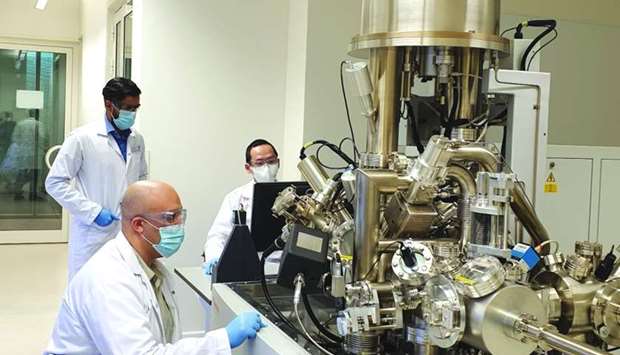Hamad Bin Khalifa University’s (HBKU) Qatar Environment and Energy Research Institute (Qeeri) has become the first research organisation in the Middle East to work on nano-rectenna devices.
Developed by scientists at Qeeri’s Disruptive Technologies Programme, these devices can be a potential game changer in the fields of sensors, detectors, solar energy conversion and nanoelectronics.
While solar cells can convert visible light into electricity via the so-called photovoltaic effect, a rectenna-based solar cell is a special type of rectifying antenna that directly converts light into electricity using the wave nature of electromagnetic radiation. The rectenna device consists of a nanoantenna, which absorbs the electromagnetic radiation and generates an oscillating current (AC); a current rectifier transforms this AC signal into DC output. The same device can be used for light sensing and detection, as well as in many other applications such as night-vision.
Dr Hicham Hamoudi, research programme director for the Disruptive Technologies Programme, Qeeri said, “There are two main technological challenges in creating efficient optical rectenna solar cells. First, the antennas should be small enough to absorb the electromagnetic waves in the optical range of the spectrum and convert them into AC current; like any antenna, they have to be of the same order of magnitude in size as the wavelength they absorb – hence, at the nanometer scale. Second, the response time of the rectifying diode must be fast enough to follow the changes in the polarity of the electron oscillations in the nano-antennas.
This is experimentally very challenging to achieve using conventional semiconductor-based technologies. In our approach, we use advances in nanoelectronics that open new vistas for rectenna technology development. In addition, the frequency of the diode should be synchronised with the high frequency voltage oscillations produced by the antennas.
“We have been able to achieve an important milestone in a relatively short period and our work has also been recognised by the international research community,” said Dr Veronica Bermudez, senior research director, Qeeri Energy Centre.
Talking about the advantages of rectenna-based solar cells, Dr Bermudez said, “Contrary to traditional photovoltaic solar cells, the rectenna system uses different process for solar energy harvesting, which can increase the conversion efficiency considerably This incredible device which is 1/1000th the size of a human hair, has multiple applications in solar energy conversion, sensors and detectors, night vision and security applications. In addition, rectennas have similar traits as silicon but are nevertheless unique and have many advantages which allow us to build a platform as an incubation zone for the next generation of solar cells, sensors, detectors, and quantum processors.”
Dr Marc Vermeersch, executive director, Qeeri, congratulated the team, adding, “Qeeri is a market-driven research institute bridging the gap between low and high technology readiness levels. This work achieved in the Disruptive Technologies group is the perfect demonstration of our ability to deploy research efforts in fundamental sciences while contemplating the market perspectives for potential applications of nanomaterials and quantum devices.”
While solar cells can convert visible light into electricity via the so-called photovoltaic effect, a rectenna-based solar cell is a special type of rectifying antenna that directly converts light into electricity using the wave nature of electromagnetic radiation. The rectenna device consists of a nanoantenna, which absorbs the electromagnetic radiation and generates an oscillating current (AC); a current rectifier transforms this AC signal into DC output. The same device can be used for light sensing and detection, as well as in many other applications such as night-vision.
Dr Hicham Hamoudi, research programme director for the Disruptive Technologies Programme, Qeeri said, “There are two main technological challenges in creating efficient optical rectenna solar cells. First, the antennas should be small enough to absorb the electromagnetic waves in the optical range of the spectrum and convert them into AC current; like any antenna, they have to be of the same order of magnitude in size as the wavelength they absorb – hence, at the nanometer scale. Second, the response time of the rectifying diode must be fast enough to follow the changes in the polarity of the electron oscillations in the nano-antennas.
This is experimentally very challenging to achieve using conventional semiconductor-based technologies. In our approach, we use advances in nanoelectronics that open new vistas for rectenna technology development. In addition, the frequency of the diode should be synchronised with the high frequency voltage oscillations produced by the antennas.
“We have been able to achieve an important milestone in a relatively short period and our work has also been recognised by the international research community,” said Dr Veronica Bermudez, senior research director, Qeeri Energy Centre.
Talking about the advantages of rectenna-based solar cells, Dr Bermudez said, “Contrary to traditional photovoltaic solar cells, the rectenna system uses different process for solar energy harvesting, which can increase the conversion efficiency considerably This incredible device which is 1/1000th the size of a human hair, has multiple applications in solar energy conversion, sensors and detectors, night vision and security applications. In addition, rectennas have similar traits as silicon but are nevertheless unique and have many advantages which allow us to build a platform as an incubation zone for the next generation of solar cells, sensors, detectors, and quantum processors.”
Dr Marc Vermeersch, executive director, Qeeri, congratulated the team, adding, “Qeeri is a market-driven research institute bridging the gap between low and high technology readiness levels. This work achieved in the Disruptive Technologies group is the perfect demonstration of our ability to deploy research efforts in fundamental sciences while contemplating the market perspectives for potential applications of nanomaterials and quantum devices.”

